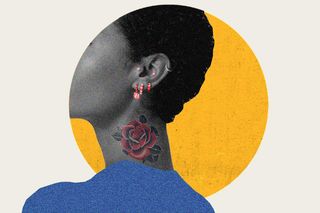
How Tattoos, Piercings Can Serve as a Coping Mechanism From Trauma
Tattoos and piercings often serve as a “means of coping with previous adversity and be an expression of autonomy.”

“[Getting a tattoo] is about transmutation — turning something so hateful into a symbol of my reclamation, healing, and solidarity with other survivors,” said Marlee Liss, a survivor of rape.
Researchers have previously explored the link between experiencing trauma, and getting subsequently inked or pierced. Now, according to a new study published in BMC Psychology, tattoos and piercings might be more common among people who endured child abuse and neglect — serving as a “means of coping with previous adversity and be an expression of autonomy.”
The researchers recruited more than 1,000 participants from Germany, aged between 14 to 44 years. 40% of the participants did, at the very least, have one tattoo or one piercing — among them, only 35% didn’t have a history of child abuse or neglect. But out of 25% of the total number of participants, who reported growing up with significant abuse or neglect, as many as 48% had either a tattoo or a piercing or both. The more severe the abuse or neglect they faced, the more tattoos or piercings the participants had, according to the researchers.
“I got Céline Dion’s autograph on my arm. I actually met her and this was her actual autograph. Céline has been my ‘safe place’ since I was a bullied teen in high school. Now in my healing journey from trauma and PTSD, she’s what I end every session of [therapy] with,” Monika S., had told The Mighty in 2018, narrating their lived experience.
The pandemic, too, has been a source of “mass trauma” for people across the globe — more than what the Second World War had left in its wake. It is hardly surprising, then, that anecdotal evidence of people getting more tattoos since 2020 is emerging — almost like surviving the pandemic propelled them to it. Ocean Gao, an artist based in New York, says, “When my studio reopened in August, I was worried people weren’t going to come… But more people wanted tattoos than before the pandemic. I think there was an excitement to practice agency, and I was tattooing a lot of designs that people said they had wanted for years.”
Related on The Swaddle:
Many Indians Are Experimenting With Psychedelics, Other Drugs to Deal With Mental Health Issues
Just like Liss, many survivors of sexual assault turn to tattoos as a source of strength — something they can draw from, and something that protects them. For Landon Funk, a professor at Columbia State Community College, a tattoo of Medusa gives her “hope, strength, and agency.” For Alicia Chung from Canada, however, the tattoos themselves assume the form of protective armor — shielding them, and giving them the courage to navigate life independently. “I protect myself by decorating myself. It’s armor… It’s my weird, twisted way of gaining autonomy,” they noted.
Upon experiencing physical pain, the brain releases endorphins, which are chemicals produced by the body to relieve pain. This eases one’s emotional distress too by working on the pain center in the brain that senses both emotional and physical pain. “I’m a tat[too] artist and a lot of my clients are also former-self harmers. Tattooing gives you physical pain and emotional release, but instead of scars, you get something cool out of it,” noted a Reddit user.
Moreover, the physical pain is also intricately linked with an element of control one feels over their bodies — and sometimes, by extension, their lives. “Unlike emotional or social pain, it’s possible to control physical pain,” Joseph Franklin, a psychologist at Florida State University, explained. And so, the pain itself can end up becoming a motivating factor behind one taking the plunge to modify their body. Especially so, since the pain is one of their choosing — based on the kind of piercings, or the designs of tattoos one chooses, they are, to an extent, controlling the degree of pain they will endure. This sense of control in a moment of helplessness and emotional turbulence makes it a coping mechanism — much like self-harm.
Backing up this explanation, an individual living with C-PTSD wrote, “[I] experienced a lot of physical and emotional abuse and tattoos let me feel like I’m reclaiming my body and healing the hurt. Also, [it’s] a lot more productive than self-harm and other self-destructive behaviors.”
Further, the fact that the pain inflicted in the process of getting pierced or tattooed is more tangible than emotional distress, makes it more appealing — its visibility affords a kind of validation that trauma survivors are often denied for their invisible scars. “Tattooing starts at the body’s first line of defense, the skin, and uses it as a canvas to physically bear witness to the assault experienced on body, mind, and sense of self. As such, it often visually and viscerally becomes a source of healing,” Suzanne Phillips, a psychologist, had explained.
Related on The Swaddle:
Why People Who Self‑Harm Struggle To Quit
Not only that, Phillips believes the visibility of tattoos and piercings can also help undo any shame one may associate with having been a victim — by acknowledging that trauma publicly, and in a frame of their choosing. According to a 2018 study on the therapeutic power of tattoos, they “act as a visual representation of a personal narrative” — offering “bodily reclamation and cathartic release.”
The association between trauma and getting inked or pierced isn’t just a cultural fact, though. The findings of the present study can, potentially, form part of more robust mental healthcare, according to researchers of the present study. “These findings open up new avenues for support offers (involving tattoo artists and piercers) and screening (in primary care). Tattoos and piercings could also provide an impetus for therapeutic conversations about the significance of past experiences and about currently important themes,” it noted.
However, it is pertinent to note that the relationship of trauma with these body-altering activities, may not apply to individuals for whom tattoos and piercings have a cultural significance. In other words, if it’s a custom to have young girls’ ears pierced as children in a certain country, then a three-year-old’s piercings won’t go on to suggest they’ve been traumatized. First, their guardians made that decision for them; second, it’s a rite of passage they may feel socio-cultural pressure to participate in, even if they’re an adult and (seemingly) making that decision for themselves.
But for the rest of us, tattoos and piercings can bear strong associations with a traumatic past — although a causal link between them is yet to be established.
In a nutshell, then, as Terri White, a British journalist, had written in her book ‘Coming Undone: A Memoir’, “[N]ow I choose to proudly see [my tattoos] as a written testament. My testament. The words and shapes and colors that tell my story before my lips can. Even if the only person listening is me. A story that began with trauma, was powered by pain, and is now defined by neither.”
Devrupa Rakshit is an Associate Editor at The Swaddle. She is a lawyer by education, a poet by accident, a painter by shaukh, and autistic by birth. You can find her on Instagram @devruparakshit.
Related


Does ‘Laziness’ Exist? Research Says, It’s Complicated
